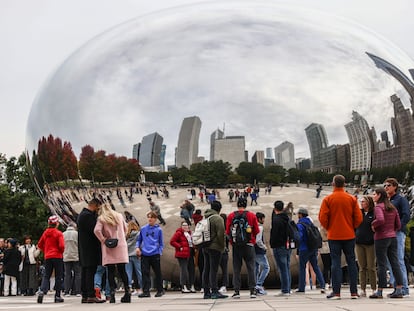The Mexican lighthouse in the heart of ‘Xicágo’
The National Museum of Mexican Art – located in the Pilsen neighborhood of the Windy City – is a home with open doors to the local community and the countless realities of cross-border and migrant identity
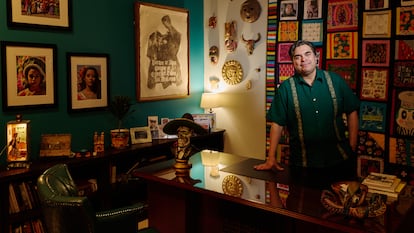

In Pilsen — a neighborhood in downtown Chicago — the corners of the sidewalks are enormous iron Aztec calendars. They remind people where the feet that step on them come from. And, in the heart of the Lower West Side neighborhood — bordered by bungalows with simple wooden fronts and small, worn porches — a mini-league baseball team plays on the bare fields of Harrison Park. The kids are guarded by a colorful mural of Quetzalcoatl — the feathered serpent of Mesoamerican mythology — and by a building that stands with defiant resistance. The Oaxacan frets that adorn its façade proudly reveal the building’s purpose from afar: it’s the National Museum of Mexican Art. But, in reality, it’s much more than a museum.
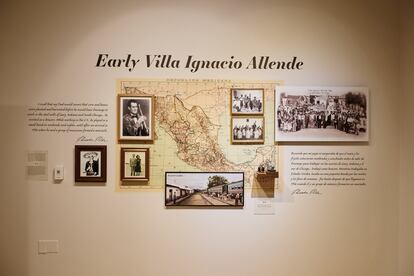
The new director is José Ochoa. Earlier this year, he replaced Carlos Tortolero, the man who founded and led the museum from its humble beginnings. Ochoa has his own metaphor to describe the place he now runs. “I talk about the museum as a lighthouse. Like you’re lost at sea and there’s a light that brings you home. It doesn’t matter if you’ve lived in Mexico your whole life; whether you’re first-generation Mexican-American, or fifth-generation; whether you speak Spanish or not, or whether you speak English or not. When you get here, you’ll recognize yourself on the walls.”
This message reverberates in a city as segregated as Chicago, which has a population divided practically into equal parts — 30% white, 30% Latino, 30% African American — and where the neighborhoods have obvious owners. Cesáreo Moreno — the museum’s chief curator for three decades — baptized his city with a new word back in 2002, when he gave the name “Xicágo” to a local exhibition of Mexican artists. Since then, this curious syncretic spelling elegantly condenses the lighthouse’s brilliance.
At the time, the museum had been running for about 20 years. It began tenuously in 1982, until it opened its doors definitively five years later. Tortolero received the original building as a donation from the city: a boathouse, used by some of the wealthiest Chicago residents to store their boats during the bitter winters of the Midwest. A simple renovation gave this warehouse the air of a museum, turning it into the custodian of an identity that represents many different ones at the same time.
At that time — around 1990 — the district of Pilsen had a population that was 88% Latino. The vast majority of residents descended from Mexican migrants who, in the 1960s, began to change an originally Czech district (hence the name in honor of the Eastern European city known for its beer), challenging virulent racism until taking over the very soul of the place. And, even then, when Pilsen was more Mexican than ever, Tortolero thought it was crucial that the inertia of assimilation not be allowed to take away from the essence of the neighborhood.
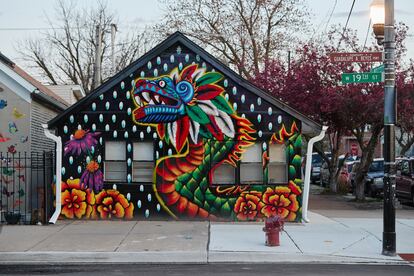
He was a visionary. Precisely from that moment onwards, gentrification began to loom. The countless taco shops became cool. Its location, highly-desirable. Slowly, rental prices rose. Many residents moved further to the west or south of the city, neighborhoods where life is less friendly and on many occasions goes hand-in-hand with poverty and violence. Today, Pilsen is 70% Latino… not a small majority, but it’s not the same. And the museum — after a major renovation in 2001 — was transformed into another metaphor: a retaining wall.
It was built with a focus on education, the natural habitat of Tortolero and those who accompanied him from the beginning. Programs and alliances were designed in collaboration with local schools. Through art, the young people of the area learned to express and discover themselves. This came to fruition in 1997 with the creation of Yollocalli (from the Nahuatl words yolotl, for heart, and kalli, for house), an initiative that, even today, offers free programming for teenagers and young people up to the age of 24. It’s the only youth program that has been awarded multiple times by the White House.
Since 2013, the museum has been located in La Villita, a neighborhood adjacent to Pilsen. It’s an open and free community space, with art rooms, laboratories, a recording studio and an important art library. From there, some 50 murals have been produced throughout the city, like Quetzalcoatl — commissioned by the Chicago Bulls — that watches over Harrison Park. The murals have even become a tourist destination in themselves. Youngsters — who receive modest remuneration — record podcasts and chat about all kinds of things. Yollocalli makes it clear to them who they are, but also that they can be whatever they want to be. After so many years in operation, there are now alumni from the program scattered throughout all areas of the city. With them, the footprint expands… but everyone knows where their home is.
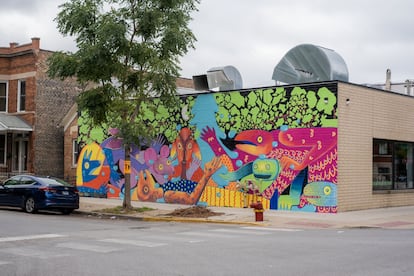
The National Museum of Mexican Art is more than a museum. Despite being the first Latino institution to become a member of the American Alliance of Museums — which allowed it to rub shoulders with institutions such as the prestigious MoMA, or the nearby Art Institute of Chicago, one of the most important museums in the world — the eyes of this institution are fixed on its community, serving it in any way possible. For instance, José Ochoa describes how the museum has even raised hundreds of thousands of dollars to help secure loans, so that residents can buy their homes and don’t have to leave the neighborhood.
“Why would a museum act like this, defending the right to housing? Well, that’s what we do... faced with any need in the community, be it the rights of women or children or migrants, we’ve been involved in services to address them. It’s like we have a gravitational pull. Whenever something happens, people come here first and ask us: what are we going to do about it?”, he says this without hiding his pride.

But he’s not satisfied, either. Ambition defines this institution; it’s averse to the stagnation that sometimes turns smaller, less glamorous museums into warehouses of dust. Since receiving the baton from Tortolero, Ochoa is aware that, along with all the work being done in the community and in the field of education, the museum must continue to grow and be — as it has always been — at the forefront.
Back in 1994, the museum organized the first edition of the Sor Juana Festival, a multidisciplinary event in honor of Sor Juana Inés de la Cruz (1648-1695) — a colonial Mexican writer and one of the most important authors in the Spanish language — with female Mexican artists on both sides of the border. Over the past 30 years, the event has received figures of high stature, including the actress Angélica Aragón, the writers Ana Castillo and Elena Poniatowska, or the musician Julieta Venegas. This year, the singer Silvana Estrada was among numerous prominent guests.
To project the light of the museum even further, Ochoa tells EL PAÍS that the first thing that must be done is to improve the financial situation. At the moment, the institution has fiscal stability, but there isn’t much room for growth. To illustrate this, he points out that the fundraising department — which actively seeks donations and alliances — has three people. Meanwhile, the educational section has about 20 workers, while the marketing department consists of one person.
But this doesn’t discourage him. As is inevitable when he’s surrounded by the vibrant energy of the museum and the overflowing decorations in his office, Ochoa talks about the future with great enthusiasm. In the coming years, they plan to open a new headquarters in Valladolid — a city in the Mexican state of Yucatán — and bring their exhibition to Madrid in 2026. The lighthouse shines brighter than ever.
Sign up for our weekly newsletter to get more English-language news coverage from EL PAÍS USA Edition
Tu suscripción se está usando en otro dispositivo
¿Quieres añadir otro usuario a tu suscripción?
Si continúas leyendo en este dispositivo, no se podrá leer en el otro.
FlechaTu suscripción se está usando en otro dispositivo y solo puedes acceder a EL PAÍS desde un dispositivo a la vez.
Si quieres compartir tu cuenta, cambia tu suscripción a la modalidad Premium, así podrás añadir otro usuario. Cada uno accederá con su propia cuenta de email, lo que os permitirá personalizar vuestra experiencia en EL PAÍS.
¿Tienes una suscripción de empresa? Accede aquí para contratar más cuentas.
En el caso de no saber quién está usando tu cuenta, te recomendamos cambiar tu contraseña aquí.
Si decides continuar compartiendo tu cuenta, este mensaje se mostrará en tu dispositivo y en el de la otra persona que está usando tu cuenta de forma indefinida, afectando a tu experiencia de lectura. Puedes consultar aquí los términos y condiciones de la suscripción digital.
More information
Archived In
Últimas noticias
Most viewed
- Reinhard Genzel, Nobel laureate in physics: ‘One-minute videos will never give you the truth’
- Oona Chaplin: ‘I told James Cameron that I was living in a treehouse and starting a permaculture project with a friend’
- Pablo Escobar’s hippos: A serious environmental problem, 40 years on
- Chevy Chase, the beloved comedian who was a monster off camera: ‘Not everyone hated him, just the people who’ve worked with him’
- Why we lost the habit of sleeping in two segments and how that changed our sense of time
